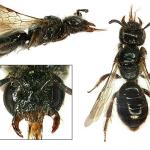Dufourea vulgaris Schenck, 1861
Dufourea minuta is the senior synonym of D. vulgaris Schenck, 1861 (Baker, 1994).
Known only from old records from Surrey (Woking and Chobham), Dorset (Holt) and possibly Hampshire (Chewton, close to the county boundary with Dorset and a doubtful record from the New Forest) until rediscovered from South Essex (near West Tilbury, leg. M E Archer, 29 June 2007). It is the most widely distributed Dufourea in Europe, ranging from Finland south to the Pyrenees and east to the Urals. Also known from west Siberia and north-west China.
Classified as Endangered (RDB1) in both Shirt (1987) and Falk (1991).
The species shows a preference for sandy soils.
The nesting biology was described by Vasiljeva (1973). The bee nests in aggregations, each female digging a main burrow vertically to a depth of about 15 cm and constructing lateral branches, each leading to a cell. The cells are ovoid in form, apparently without a lining. The pollen is formed immediately into a rather dry ball and an egg laid. On completion of feeding, the larva spins a small, light brown cocoon.
Only daisy - Asteraceae family flowers are known.
No information available for Britain, but a Sphecodes is recorded in continental Europe.
2012


